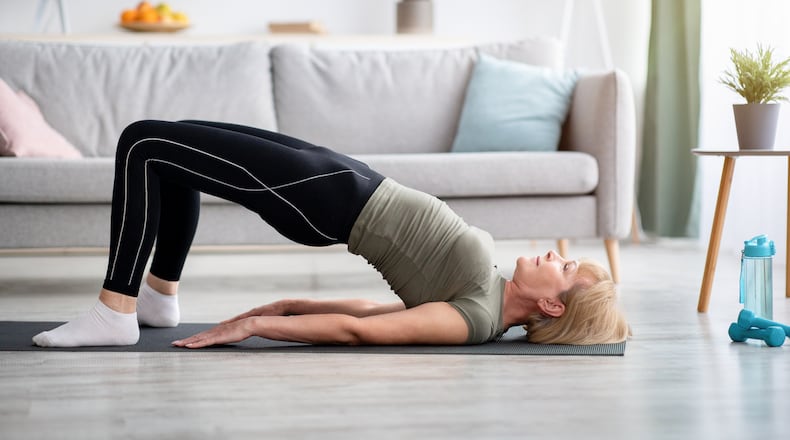Starting position: Lie on the floor face up, with knees bent and feet about hip-width apart. Relax the shoulders and arms and place them at your sides. To help keep the arms from pushing against the floor, turn the palms upward. This also helps to open the front shoulder area, which is tight in most people.
Strengthening phase: Pushing down with the heels, slowly lift the hips from the floor as far as comfortably possible, then pause and contract/tighten the gluteal (rear end) muscles. With sufficient strength the body will be in a straight (diagonal) line from the shoulders to the knees, without the back rounding. If lifting to this degree is not possible, come up as high as your current strength level will allow, as benefits can still be gained. To finish the repetition slowly lower the body and briefly rest before continuing.
Tips:
- The Bridge can also be performed by doing a posterior pelvic tilt first, followed by the lifting phase. Another variation, if strong enough to keep proper form, is a Single Leg Bridge. In this case, only one foot is in contact with the floor while the other leg is straightened and held in place while rising and descending.
- To add inner thigh strengthening to the Bridge, place a firm pillow or Yoga block between the knees and press against it at the top of the repetition for several seconds. Pushing bodyweight through the heels of the feet as the hips are raised places emphasis on the glutes to a slightly greater degree and can help diminish stress on the knees.
- Reps, sets and frequency: Depending on goals, you can hold at the top of each repetition for the desired number of seconds. As for the number of repetitions and sets, this can vary widely from person to person. The Bridge typically can be performed every day.
- The Bridge is considered by most physical therapists as safe for those who have a weak or injured back. However, as with all exercises, check with your doctor for guidelines if you have pre-existing conditions or are not accustomed to physical activity.
- Some people find that the hamstrings begin to cramp once hips are raised. If this happens during the Bridge, stop and stretch by extending the leg fully and lift it toward you with a flexed foot, which will help provide relief. If cramping returns once the exercise is resumed, make a point to stretch the hamstrings before doing the first repetition and/or placing the feet somewhat further away from the body to slightly extend the legs.
About the Author

